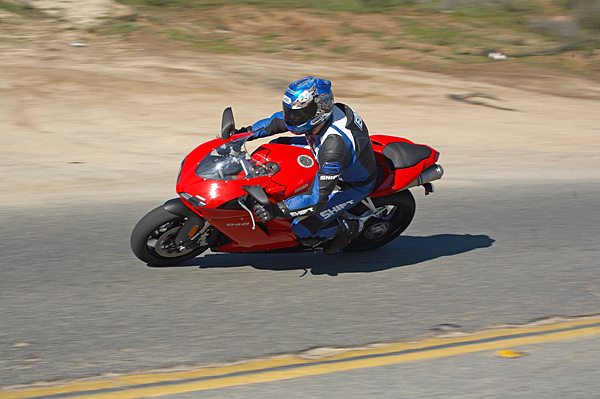
The guy on the BMW R1200 was buzzing my new Ducati 848 test bike pretty relentlessly as I made my way up the Pacific Coast Highway to some canyon roads I know. He’d thread his way to the head of the line at red lights, then blast away with an angry buzz from his flat-twin when the lights changed. If I picked a better lane and left first, he’d storm past as soon as he cleared traffic.
Street racing is one of the dumbest things you can do on a motorcycle, so I just treated the whole thing as a joke for a few miles, watching with amusement as this guy weaved in and out of traffic, gunning the BMW hard through gaps. But then we arrived at a set of red lights with a big open gap ahead. By now I’d figured he was probably more curious about what this strange new Ducati could do than he was about initiating an irresponsible drag race on public roads, so I left the lights hard, letting the desmo twin spin right up in first gear.
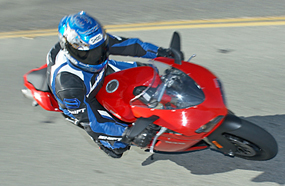
The 848 pulls enthusiastically in the bottom half of its 10,500-rpm range, but there’s an impressive hit at about 8,500 rpm, and it picked the front wheel off the PCH pavement and held it there until the shift lights flickered for attention. That single blast of power is all one needs to drop off curious R1200 owners, and it clearly differentiates the 848 from its modestly endowed 749 predecessor. (In fact, Ducati points out that the 848’s new engine/chassis combination provides the same power-to-weight ratio as the old 999.)
Ironically, the 749 this new bike replaces was engineered with a greater expectation that it would compete in World and local Supersport championship races, making it arguably less friendly as an everyday mount. The 848, says Ducati, is biased toward regular road use, even though the company would undoubtedly love to see this displacement legal for Supersport racing. Either way, its mechanical similarity to the performance-fixated 1098 family is indisputable, and some of that devotion to track prowess shows.
We’d picked up our Ducati 848 test bike from a shop in Brea, California, which is a moderately long freeway stint from home. On the way back there had been plenty of time to muse that the riding position, suspension settings and creature-comfort levels of sport bikes in general has been increasingly compromised by their relationship to racing versions of the same models.
Because so many racing classes are based on production machinery with limited modifications allowed, it’s become necessary to build bikes close to their track potential to make them competitive once they’re modified. A lot of riders like that. They want race-ready bikes and are prepared to put up with some discomfort in the process. Initially, the new Ducati 848 felt like one of those machines. After all, it was developed from the 1098 family of Ducati twins, and that’s a model honed and pared down to fighting-fit levels for its all-important transformation into a potential world-champion superbike.
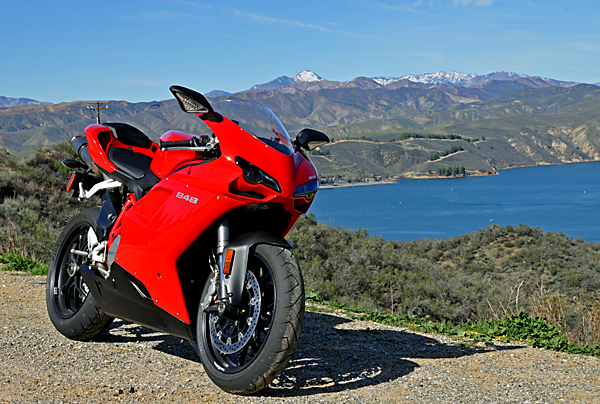
As a result, the riding position places quite a bit of weight on the rider’s wrists, something you notice particularly in heavy traffic. It’s a more dedicated riding position than you find on many contemporary Japanese sportbikes, and had us thinking we might have to come right out and say that although the new Ducati will be revered for its Italian mystique and design in the same way Ducatis always have been, we consider it somewhat inappropriate for real world applications.
Then we noticed that the ride wasn’t at all bad, and that the 43mm Showa fork was doing a great job of swallowing the concrete joints and bumps. The rear shock wasn’t sending any abrupt seismic messages through to the seat either. And the seat itself is wide and shaped well enough to spread the pressure evenly across the entire area of contact. At a high cruising speed (could’ve been 90, officer, but I can’t swear to it), the 849cc L-twin is smooth and quiet, with plenty of urge available at the twist of the grip.
Thanks in part to a new trellis frame with a wider cross-section and thinner walls, and the stiff single-sided rear swingarm that returned with the 1098, there’s a reassuring stability in the way the bike tracks, so it slices through gaps in traffic with total accuracy. With a comparatively long wheelbase (at 56.3-inches), and what feels like pretty even weight distribution, the 848’s chassis is so well damped it isn’t even fitted with a steering damper.
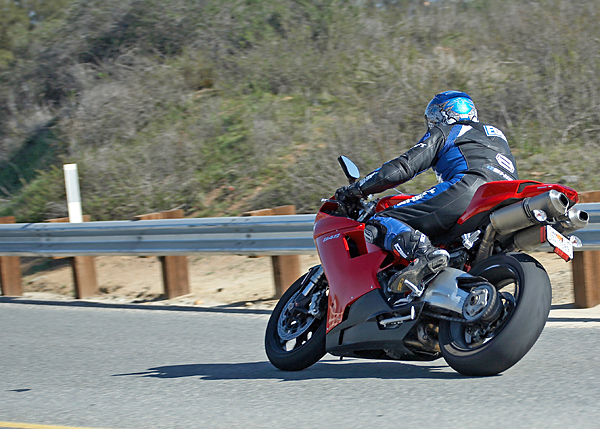
Considering the fork’s 24.5-degrees of rake and 3.8-inches of trail, we expected a whippier front end than we got. Even the significant front-wheel lightness that resulted from hard drives off corners failed to shake the 848’s ‘bars, which remained reassuring and stable despite their surprisingly light heft. It’s strange that the wizards that tuned this steering then allowed the installation of a fairing that fouls the rider’s hands at full lock.
Then again, perhaps it was just the kind of compromise Ducati’s engineers had to make to retain decent streetability with efficient aerodynamics. This is the kind of thinking-usually just after you’ve swung the machine through a few of your favorite curves-that turns people into Ducatisti. The 848 is just so good on a twisty road that one starts to believe that there’s a good reason for everything the Borgo Panigale factory does.
Although the wheelbase is fairly long, the center of gravity is low, so the 848 turns in willingly, and its taut chassis holds lines so well it feels like the bike is riding itself. What’s really happening is that it’s simply going where the rider aimed it, with no corruption of the line. Applying the front brake picks the bike up a bit, but that just encourages you to lay it over a little further to get it turned. Once you understand exactly how much effort is required to steer the 848, the clear communication between control input and response puts the bike exactly where you want it. This, friends, is a seductive handling attribute, making you feel more than ever that Ducati engineers can do no wrong.
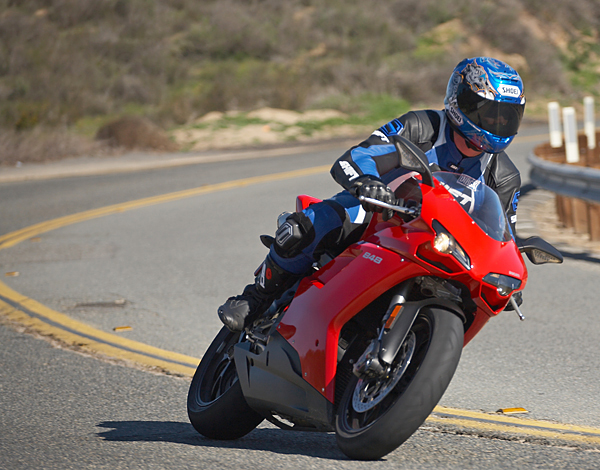
That benign faith lasts until you start to use the mirrors on a fast and merciless road like the Riverside Freeway in L.A. Then you discover in short order that these appalling items are little more than glorified turn-signal housings. Firstly, they’re mounted too far inboard, so all you see are your forearms. Secondly, they are too small to provide a meaningful image. Thirdly they lack sufficient adjustability to move to an optimal spot. Finally, and most egregiously, the damn things vibrate hard enough to whip rearward reflections to frappé.
On a bike with enough mid-range torque to encourage high-speed traffic slaloms, this rearward blindness is not reassuring. Nor does it offer any warning of the presence of The Man, something you might want on a fast bike with about 117 rear-wheel horsepower (Ducati claims 134-horsepower at 10,000 rpm, at the crank).
But otherwise, it’s hard to find a fly in this otherwise soothing ointment. The fuel-injection system has new oval throttle bodies and meters fuel precisely at virtually all engine speeds. We managed to stall once or twice at just-off idle speeds that suggest either ham-handedness on our part, or a little throttle-response softness at those revs. The big V-twin (or L-twin, as Ducati prefers to call it) is flexible enough to pull steadily from 2,000 rpm, but like most big twins, big throttle openings at relatively low revs produce low-frequency thudding vibrations. One needs 4,000 rpm or so for perfectly smooth full-throttle responses.
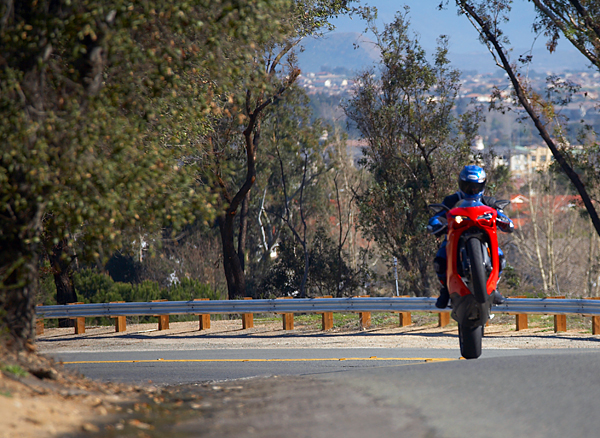
We’ve heard complaints about 848 shifters being less than smooth in operation, but can’t say this was the case with our bike. The red 848 snapped up gears effortlessly during hard acceleration, while rev-matched downshifts slipped into engagement just as eagerly. The hydraulic clutch-with its dinky little fluid reservoir-provided reasonably light pull action, too.
The other lever controls brakes quite different from those found on the big-brother 1098s. Ducati 848s have 320mm discs and two-pad monobloc calipers instead of the 1098’s 330mm discs and four-pad system, but we liked the setup a lot better for street riding. There’s less initial bite, but the system’s response to increasing lever pressure is admirably linear, allowing you to add braking force predictably as needed. The 1098’s brakes may be better for track use, but the ferocious response to even light lever pressure just feels over-powered in everyday use.
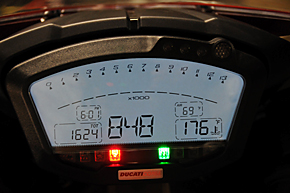
Just as on the 1098 siblings, the 848 wears a MotoGP derived instrument panel with its liquid-crystal tachometer arc and digital speedometer. It retains the multi-function properties, too, with an integral laptimer, count-down tripmeter on reserve, and track time data-logger that can be downloaded with Ducati’s optional DDA gadget. While the panel certainly looks true to its MotoGP inspirations, we think it’s a bit monochromatic on such a flamboyant streetbike. Functional, yes. Decorative, not so much.
But that’s not a charge you can make about the bike in general. Our bike was just gorgeous in the new red and black two-tone fairing design, and looked good enough to bring indoors. The single-sided swingarm shows off those Y-spoked Marchesini wheels to great effect, and even the “biposto” pillion-passenger pod has been tidily integrated into the overall profile. The price, at just under thirteen grand, is equally attractive.
There’s always going to be a tendency among Ducati enthusiasts to buy the flagship model, and the old 749’s controversial looks and mediocre power definitely supported that inclination. But now there’s real argument that the 848 may be a better balanced machine for most riders’ real-world needs. There’s more than enough performance from this new engine for most people, along with an attempt at a workable compromise between tolerable comfort levels and dedicated track-attack dynamics.
Okay, the 848’s new wet clutch banishes the tell-tale Ducati stoplight rattle, but the bike is otherwise an embodiment of the company’s successful new direction. With a MotoGP World Championship in the bag and promising World Superbike and MotoGP prospects for 2008, Ducati is riding high. Like riding the new 848, it’s a good feeling.
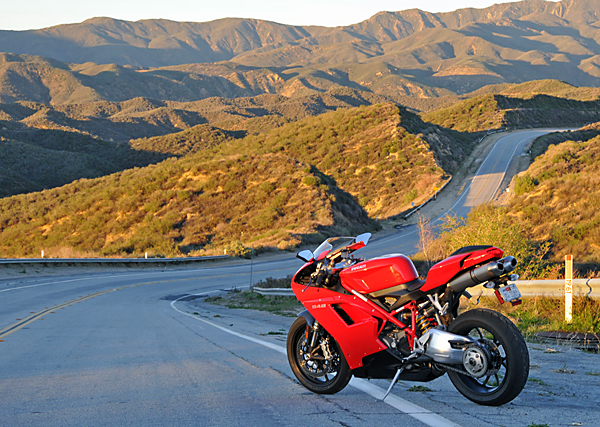
Our test bike returned a low of 42 mpg (after a freeway stint where we used 5th gear rather than 6th) and a high of 51 mpg. For additional details and specifications, visit Ducati’s web site here





